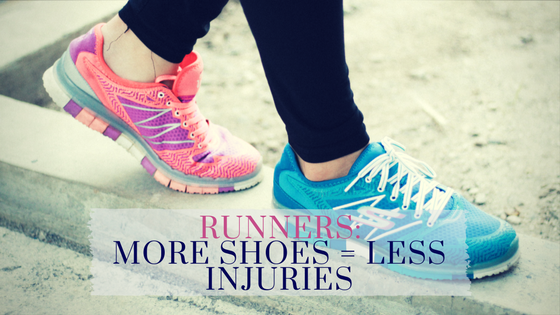
Let’s be honest. Who doesn’t love buying running shoes? I know we complain about the price and how the brands discontinue our favourite model every year. But if we are really being honest with ourselves, we love buying running shoes.
I know I do. I reckon I did about 4-6 hours of research online before narrowing my latest pair down to two choices. I had my options narrowed down to two models from Altra. It was the V3 vs the Escalante. I bought both pairs from Sports4 in Ottawa and took them for an extended test drive on the treadmill. After much deliberation, I went with the Escalante.
I had a good moan about the $200 price tag, but if I’m honest, I loved every minute of it!
Many runners have closets full of running shoes. This was once the shameful indulgence of the recreational runner. However, new research is showing that, rather than being senseless commercialism, running shoe hoarding may actually be a scientifically valid injury prevention strategy!
Can Using Different Running Shoes Reduce Injury Risk?
Researchers from The Sports Medicine Research Laboratory in Luxemburg conducted a study of injury rates among 264 recreational runners. They got the runners to log their training online for 22 weeks and report any and all injuries. They defined an injury as a “physical pain or complaint located at the lower limbs or lower back region, sustained during or as a result of running practice and impeding planned running activity for at least 1 day”.
An easier way of saying this is that a running injury is anything that makes you alter your training. That’s how I define an injury as opposed to a niggle (a niggle being a transient pain that doesn’t affect your training).
They classified the runners as “multiple shoe users” or “single shoe users”. Basically, this means that the multiple shoe users wore more than one pair of running shoes each week whereas the single shoes users wore the same pair of running shoes all the time.
When comparing the multiple shoe runners with the single shoe runners the researchers found that the multiple shoe runners had a significantly lower risk of developing a running injury and concluded:
“…runners using concomitantly more than one pair of shoes had a lower risk of RRI [Running Related Injury]”
The researchers explained these findings by suggesting that different shoes would cause the stresses placed on the body to fall in different places. This could add some variety in tissue loading to a very repetitive sport. Here’s how they word it:
“A possible explanation would be that the alternation of running shoes induces a variation in the type of physical load applied to the musculoskeletal system.”
They go on to cite some studies showing that the characteristics of different running shoes will in fact alter the physical loads experienced by different parts of the body. They cite a paper that showed new running shoes increase peak loads in the foot and ankle and recommended that we transition gradually when we buy a new pair of running shoes – Amen to that! (Rethnam & Makwana, 2011). They also cited a couple of papers that showed running technique (kinematics) are altered by different types of running shoe (Nigg 2012 & Kong 2009). Then they discussed a paper showing that muscle activity changes occur in different running shoes (Wakeling 2002).
All this to say that different running shoes affect the way you run. Running in different pairs of shoes each week will make you run a little differently each time. This may move the loads around a bit more and reduce the risk of overloading a given tissue.
What This Means for Runners
Let’s go shopping!
Having multiple pairs of running shoes in weekly rotation seems to be a reasonable injury prevention strategy. So, if you are doing all your running in the same pair of shoes, you can now scientifically prove to your partner that you need to buy more running shoes.
Be sure to introduce your new shoes gradually and let your tissues adapt. If you are planning to add to your running shoe wardrobe, you might be interested to read the following blogs first:
Are Your Running Shoes Slowing You Down?
How to Transition to Minimalist Running Shoes Without Getting Injured
Take Home Message
I would say the most important message to take from this study is not “buying more running shoes is good” but rather “variety is good”. Adding some variety to your running training in order to mix up the way load is applied to your body is one of your best defences in the battle to avoid running injuries.
Trail running is an excellent way to mix up the way loads are applied to your body when running. Adding some cross training and strength training are other good ways. You can also vary the types of run you do. Do some tempo runs, some intervals, some hills, some long runs, some easy runs. Run on the road, run on the grass, run with a stroller, run with your dog, run backwards (okay, I’m being silly now).